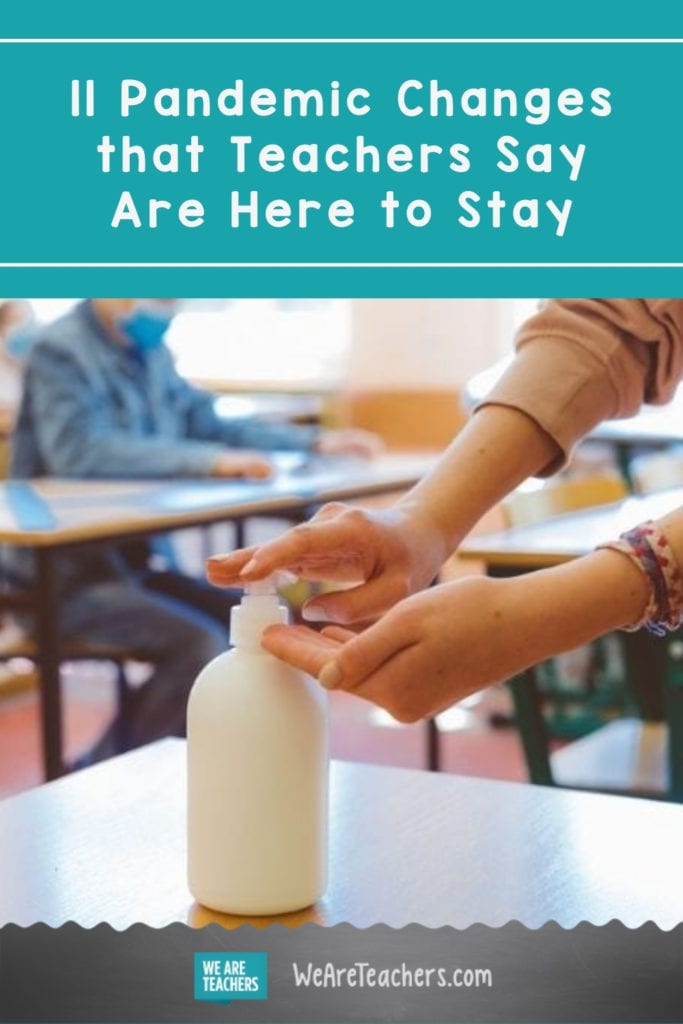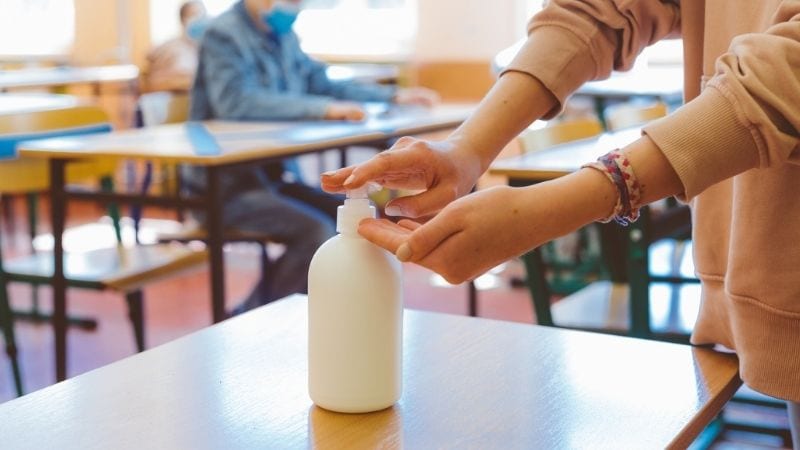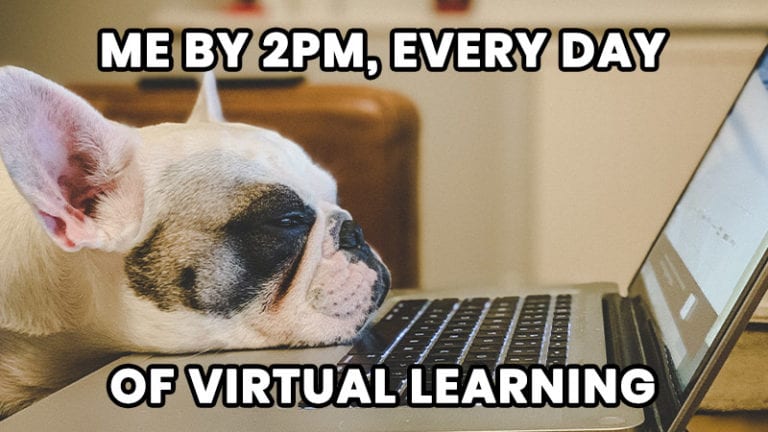The pandemic has drastically changed many things we do as a society—especially in education. Teachers and administrators scrambled for creative solutions. And, despite the steep learning curve, they’ve found that many practices we’ve put into place are worth keeping. So when one of the teachers in our WeAreTeacher HELPLINE group on Facebook posted this question: “What changes to your teaching/classroom from this crazy year will you as teachers continue after COVID?” we were eager to hear what everyone had to say. Here is a roundup of their answers.
1. Innovating with technology
Even though many teachers had a steep learning curve, most were pleased to learn that technology actually helped them manage their workload more efficiently. Over and over, teachers who responded sang the praises of Google Classroom, Google Forms, and Google Slides. “I love using Google Classroom,” says Olive G. “I post all my lessons and notes for the kids to access. And there’s one central place to turn in assignments. It’s especially useful when students try to pull, ‘But I turned my assignment in, you must have lost it!'”
Anita O. mentions the convenience of online grading. “I’m going to keep putting most of my graded assignments in Google Classroom,” she says. “I LOVE not having stacks of papers to grade.” Dianne H. likes using Google Forms to progress monitor. She creates a quiz for students to take, then allows them to self-grade. Students who answer questions incorrectly can keep working and edit responses until they get them right. And then, she can spend time reteaching students who are confused.
2. Using video to boost learning
Teachers have discovered that video capability has increased their versatility as an educator exponentially. Like many teachers, Anthony P. plans on continuing to record his lectures and classes so that absent students can reference what they missed. And after teaching online this year, second-grade teacher Shelly M. is planning on using videos to a much greater extent as an instructional tool. “I have collected a bunch of content videos that I can assign to students to help fill any gaps,” she says. “In addition, I do a scripted phonics program with my intensive readers three times each day, which I now have on video too. So I could have a small group use the video while I teach a different skill in another small group.”
Tim A. is planning to add a Promethean board to his woodshop. “There are so many good videos out there of topics that I just can’t do justice to,” he says. Sarah R. suggests recording a video rather than writing detailed plans for substitute teachers. And P.J. G. recommends assigning videos as an assessment tool. “Students can use Flipgrid or Google Forms to create a video that demonstrates their understanding using their own voice instead of writing everything down,” he says.
3. Connecting in creative ways
Video conferencing has dramatically changed the way the world meets up. And while many teachers grew weary of having it as their only tool, Zoom (and others like it) opens up possibilities for more efficient, effective communication.
“I would love it if we could do parent-teacher conferences on Zoom,” says Marcy K. “It’s so much more flexible. Instead of having to leave work in the middle of the day, drive to school and wait their turn, parents could schedule a half hour and meet with me virtually. It would be a huge timesaver and be more convenient for everyone.” Heather S. would like to see staff meetings go virtual for teachers even after COVID. “They are always so much shorter than in-person meetings, and more efficient as well.” Finally, Madelyn A. plans on holding digital office hours to be more accessible to her students.
In addition, many teachers report their schools are holding digital open houses, back to school nights, PLC meetings, data meetings, and more. One teacher notes that the change has boosted attendance through the roof.
4. Making room for students who may not like the spotlight
Interestingly, teachers have noticed that some students have blossomed with online learning. “Some of my quietest students have found their voice,” says Deanne S. “They love being able to answer questions without worrying about other students seeing their answer and being able to ask questions without having to ask in front of the class. I feel like I’m getting to know them on a deeper level because they seem to feel safer being able to communicate with complete privacy from other students overhearing.”
Singing the praises of the chat feature, Daniel P. reports, “I keep the chat running alongside my lesson so as we do problems kids type in answers or questions as I’m teaching. I have the chat so it goes only to me so others can’t see their answers or questions.” And Anneka N. has appreciated giving her students options for communicating. “I like that online, I can switch between using the chat or calling on kids,” she says, “giving them the option to write stuff down instead of ONLY using verbal communication.”
5. Embracing alternative forms of learning
When learning shifted from the traditional classroom model to online learning, teachers realized things would have to be done differently. Concepts liked self-paced learning and flipped classroom resonated with many educators and students alike. That’s why Rachel E. tells us she plans on maintaining a self-paced classroom. “That way,” she says, “I can help the kids that need it most, and my higher kids can get challenged too.” And Joe M. liked the efficiency and flow of a flipped classroom. “When everything eventually goes back to normal, I want my students to continue to watch the lessons at home, so then I can do math groups and activities in class.”
6. Cutting down on environmental waste
Moving to virtual learning has had a huge side benefit—less environmental waste. Teacher Cyndie A. predicts the change is here to stay. “In the future, I think notebooks and binders won’t even be used anymore,” she says. Having students with online skills means I can move away from using paper, which is more earth-friendly.” Merika C. agrees. “I’ll stay mostly paperless—especially for graded assignments,” she says. “My shoulders and back are much happier toting a computer than massive piles of papers, packets, and workbooks to grade!”
7. Establishing personal boundaries
The bombardment of changes the pandemic has forced on teachers has inspired deep contemplation about the need for self-care and work-life balance. And many are coming to the conclusion that in order to not just survive, but thrive, personal boundaries are a must. For Beth A., that means drawing the line at looking at work email on weekends or holidays. “And no more buying supplies for my classroom,” she says. Valerie P. puts it this way: “I plan to continue to give myself permission to my own time, leave work at school, and say no to extra responsibilities. I will take care of myself first.”
8. Giving students space
Teachers have really gotten creative in order to maintain social distancing in their classrooms, and many of their ideas are keepers. “My kiddos just thrive having their own space,” says teacher Megan G. “So I will continue to do flexible seating with extra chairs. Each day kids can choose a seat and bring it to their space, rather than each table having designated chairs.” Kindergarten teacher Ali S. shares that her students have loved having individuals desks instead of tables. “And I’m not giving them up!” she says. “Having individual space has alleviated the nit-picking that comes from ‘she’s touching me, he kicked me under the table,’ etc.”
Social distancing has put a spin on transitions as well. Carlie A. reports, “We’ve been transitioning one class at a time and using both inside and outside paths at the same time. The hallway is so much calmer. I can see it really decreasing discipline and drama if we can make it work long term.”
9. Wearing masks when needed
It took a lot of getting used to, and most people won’t be sorry to see them go, but teachers admit even after COVID that they see the benefit of using masks in the future. “I really hope schools allow masks after this is over,” says Valerie T. “If a child has a cold they, should wear a mask! And if not, then I will wear one because I went from having 1-2 colds or sinus infections a month to having none since March.” Beth S. concurs, “We have had WAY fewer colds and ZERO flu cases so far in my class!”
10. Staying on top of hygiene
Wipes, sprays, foggers—schools came up with intense ways to kill germs in the classroom and common spaces. And though it made for extra work, teachers would love to keep hygiene standards high. “I hope we keep up with cleaning desks,” says Jennifer S. “I can’t believe we haven’t been doing this all along. It’s so easy, and I think it really cut down on illness.”
In fact, learning how to pay attention to sanitation can be an important life lesson for students. “After I spray the desks, my students wipe them down,” Sharene D. says. “The other day, they were marveling at all of the fingerprints and stray hairs all over their desks. I guess my fine mist sprayer made them really noticeable. The kids were so grossed out.”
11. Being grateful for our students
One thing seems certain—teaching will never be the same again. But at its core, the profession remains rooted in deep love and respect for kids and learning. Not that teachers ever forgot that. For those who remain in the field, the purpose of it all just became crystal clear. As Kaylie M.puts it, “I have missed my students so much! I will never take being together in person for granted again.” Erin O. adds a measure of humor to the sentiment, “I will appreciate the little things—even lunch duty!”
What elements do you think teachers should keep after COVID? Are there any lessons from the pandemic you will take into your teaching practice in the future? Come share in our WeAreTeachers HELPLINE Facebook group.
Plus, 16 Teachers Share How They Are Creating Boundaries Right Now.


